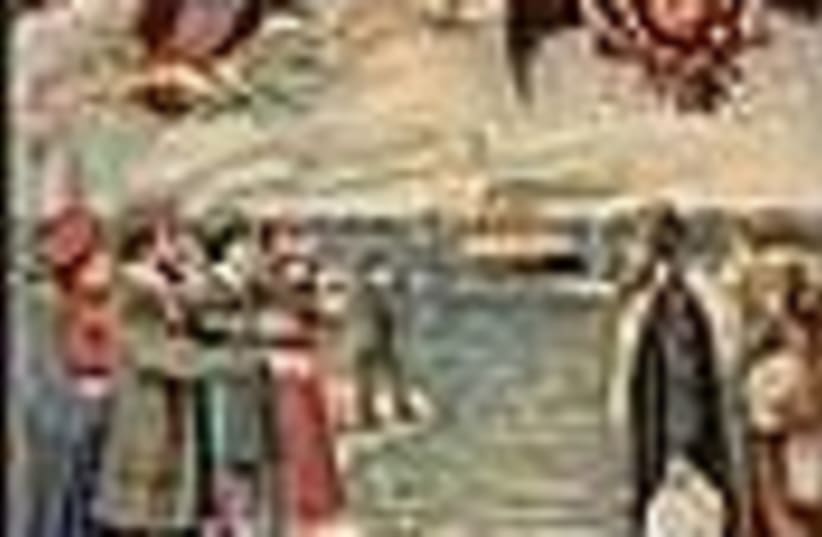The hundreds of Jewish new year greetings in the Paz collection, sent by Jews expressing hope for a better, sweeter year to come, were drawn by hand or printed using now-defunct printing methods.
Paz, a Jezreel Valley kibbutznik, is best known for his superb collection of Haggadot created by or for Jewish soldiers during the World War II. His cupboards, shelves and drawers brim with memorabilia including badges, insignia, emblems and documents.
"I began with collecting Haggadot, and during my research I came across so many other interesting artifacts that eventually the collection began to embrace items used by Jewish soldiers, Holocaust survivors in displaced persons' camps and internees of British detention camps," says the kibbutz-born collector. "Jews held in the British detention camps of Cyprus, Eritrea, Mauritius and Atlit (in Palestine) produced some amazing artwork whether paintings, etchings, models, toys, Rosh Hashana cards or Haggadot."
Apart from the Rosh Hashana greetings from Europe and Africa, the Paz collection includes a number of cards produced by the pre-state kibbutz movement, as well as those sent by fighters with Etzel and Hagana militias. "The most difficult Rosh Hashana greetings to find are those from the Jewish Brigade and displaced persons' camps," he says.
He gingerly removes from one of the albums' double plastic pages a small card the size of a cigarette packet with a black-and-white photograph of the Rozenbergs - a family of three, Pejsech, Rosa and Feige, who were inmates at Bergen-Belsen after it became a displaced persons' camp. The photograph had been turned into an impromptu Rosh Hashana greeting card in l946 or l947.
"This is a rather rare card among collectors," says Paz, who has no knowledge of where the Rozenberg family was sent after Bergen-Belsen.
An eye-catching card in the collection is one with a clock on the top left-hand corner, its hands at 06:50. The time-keepers were Jews from Palestine who volunteered for the British Army before the Jewish Brigade was formed. They served in the 650 (hence the 06:50 on the clock) Transport Troop and were overseen by British officers.
"The 650 Transport Troop began serving in 1942 in Alexandria, Egypt, and by l943 were moved to Europe, mainly based in Italy transporting supplies from one country to another. This particular card is from l945, a year before they were disbanded," Paz recounts.
Another card in his fascinating collection was created by a group of Jews from Palestine serving in the regular British Army alongside others known as the Buffs. These soldiers coined a name for themselves, "The Diggers," and their l941 Rosh Hashana cartoon card depicts them as dwarves with shovels, being overseen by another dwarf wearing a British officer's cap. "The Diggers saw themselves as the Seven Dwarfs, marching off to work with shovels slung over their shoulders instead of off to fight with guns in their hands; they were very angry at not being treated as what they considered to be soldiers. They dug trenches and some fell into captivity and were sent to camps, first in Greece and then to German-controlled camps such as Lamsdorf," says Paz, slipping the pick-and-shovel characters back into their cover and taking out another interesting card.
This one is from the Etzel, circa l943. A tough-looking character clutches a gun and the background is a map depicting Israel covering both sides of the Jordan River. The gun clutcher's finger points to Jerusalem.
Paz draws out a Rosh Hashana card from l944 celebrating the founding of the Jewish Brigade. On it, Jewish soldiers ride atop tanks with the Israeli flag flying proudly, overseen by a stern-looking British brigadier in the corner. "This card was actually celebrating the fact that for the first time, the British allowed the Jews from Palestine to carry their own Magen David flag while they were in British uniforms," he says emotionally.
Also among the documents is a simple sheet of paper - an official form of the British Army, known as an airgraph. On one side is a picture of a handshake; across from the hands is written "C.M.F. September, l944"; underneath in large block Hebrew letters, "Shana Tova" and a prominent decorative Magen David.
In English is written "A Happy and Victorious New Year." On the flipside are very official instructions as to how the soldier should fill out his message for Rosh Hashana and where to affix the threepence worth of stamps to ensure it gets sent. Apparently the message inscribed and addressed to where it should go were transferred to a miniature photographic negative and sent by airmail.
"At the destination end a photographic print, measuring about 5 inches by 4 inches, will be made and delivered to the addressee," the other side of the greeting form coldly states. The last of the seven instructions reads: "The original will be retained for a period by the Army Post Office and eventually destroyed."
